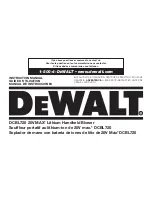
10
Changing Throw Direction and
Throw Height
m
WARNING!
Never direct the snow discharge chute at the
operator, at bystanders, at vehicles or at nearby windows. The
discharged snow and foreign objects accidentally picked up by
the snow blower can cause serious damage and personal injury.
Always orient the discharge chute in the opposite direction from
where you, bystanders, surrounding vehicles or windows are
located.
1.
The discharge chute can be adjusted 180 degrees by
pressing the chute rotate button in the desired direction
(Fig. 14).
2.
The chute deflector on the top of the discharge chute
controls the height of the snow stream. To adjust the height
that the snow is thrown, squeeze the trigger on the chute‑
deflector handle, and then raise/lower the chute deflector.
Release the trigger on the chute deflector handle to lock
the chute deflector in place (Fig. 15).
NOTE:
ALWAYS position discharge chute deflector at a safe
angle before engaging the auger. DO NOT throw snow any
higher than necessary.
Press to turn
chute right
Press to turn
chute left
Fig. 14
Chute deflector
trigger
Fig. 15
LED Headlights
The LED headlights are located on the front of the snow blower
(Fig. 16).
1.
To turn on the LED light, press the LED light button
(Fig. 17).
2.
To turn off, press the LED light button again.
NOTE:
After you have finished using your snow blower,
remember to turn OFF the LED light button.
Operating Tips
m
WARNING!
Foreign objects, such as rocks, broken glass,
nails, wire, or string, can be picked up and thrown by the snow
blower, causing serious personal injury. Remove all foreign
objects from the area to be plowed before operating the snow
blower.
Snow is best removed as soon as possible after snow fall.
1.
Keep the area of operation free of foreign objects that
can become thrown by the blades. Perform a thorough
inspection of the area since some objects may be hidden
from view by surrounding snow. If the snow blower hits an
obstruction or picks up a foreign object during use, stop the
snow blower, remove the battery, remove the obstruction,
and inspect the unit for damage. Repair or replace any
damaged part before restarting and operating the unit.
2.
Keep children, pets, and bystanders away from the area of
operation. Be aware that the normal noise of the machine
when turned on may make it difficult for you to hear
approaching people.
Fig. 16
LED lights
LED light button
Fig. 17











































